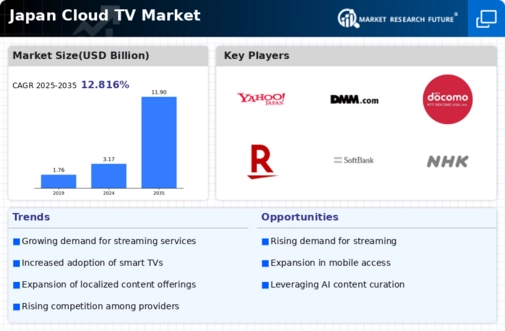Rise of Mobile Streaming
The rise of mobile streaming is significantly impacting the Cloud TV Market in Japan. With the proliferation of smartphones and tablets, consumers are increasingly accessing cloud tv services on-the-go. Recent data suggests that mobile devices account for nearly 50% of all streaming traffic in the country. This trend is prompting cloud tv providers to optimize their platforms for mobile use, ensuring that users can enjoy high-quality content regardless of their location. As mobile internet speeds continue to improve, the potential for growth in mobile streaming within the cloud tv market appears promising. This shift may lead to the development of exclusive mobile content, further attracting a younger demographic.
Competitive Pricing Strategies
Competitive pricing strategies are becoming a pivotal driver in the Cloud TV Market in Japan. As the number of service providers increases, companies are adopting various pricing models to attract and retain subscribers. Many platforms are offering tiered subscription plans, allowing consumers to choose packages that best fit their viewing habits and budgets. Recent market analysis indicates that around 40% of consumers are influenced by pricing when selecting a cloud tv service. This competitive landscape encourages providers to innovate not only in content but also in pricing strategies, potentially leading to more affordable options for consumers. As a result, the cloud tv market is likely to see an influx of new subscribers, further fueling its growth.
Increased Internet Penetration
The Cloud TV Market in Japan is experiencing a notable boost due to the increasing penetration of high-speed internet services. As of November 2025, approximately 95% of households have access to broadband internet, facilitating seamless streaming experiences. This widespread connectivity enables consumers to access cloud tv services without interruptions, thereby enhancing user satisfaction. The rise in internet users, estimated at around 120 million, indicates a growing audience for cloud tv platforms. Consequently, service providers are likely to invest in content delivery networks to ensure high-quality streaming. This trend suggests that the cloud tv market will continue to expand as more consumers embrace online viewing options, driven by the convenience and flexibility that cloud-based services offer.
Shift in Consumer Viewing Habits
The Cloud TV Market in Japan is witnessing a significant shift in consumer viewing habits, with an increasing preference for on-demand content over traditional broadcasting. Recent surveys indicate that over 70% of viewers prefer streaming services for their flexibility and diverse content offerings. This change is prompting traditional broadcasters to adapt their strategies, often integrating cloud tv solutions to meet evolving consumer demands. As a result, the market is likely to see a surge in partnerships between traditional media companies and cloud tv providers, enhancing the overall content library available to consumers. This shift not only reflects changing preferences but also indicates a potential for growth in subscription-based models within the cloud tv market.
Technological Advancements in Streaming
Technological advancements are playing a crucial role in shaping the Cloud TV Market in Japan. Innovations such as 4K streaming, artificial intelligence, and machine learning are enhancing user experiences by providing personalized content recommendations. As of November 2025, approximately 30% of cloud tv subscribers utilize 4K streaming services, indicating a growing demand for high-definition content. Furthermore, the integration of AI-driven analytics allows providers to better understand viewer preferences, leading to more targeted content offerings. This technological evolution not only improves user engagement but also positions the cloud tv market as a competitive landscape where providers must continuously innovate to retain subscribers.

















Leave a Comment